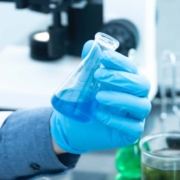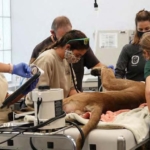The Battle Against COVID-19
 We are witnessing one of the great scientific achievements of our lifetime.
We are witnessing one of the great scientific achievements of our lifetime.
Confronted with a public health catastrophe – a viral pandemic that has killed 1.9 million globally, over 360,000 in the U.S. and over 22,000 in Florida – the pharmaceutical industry made a miracle. It did in 7-8 months what normally takes 7-8 years.
In short order, bolstered by scientists around the globe, Big Pharma discovered, tested and began large-scale manufacture of highly effective vaccines. Two and likely as many as four will be available for treating millions of people in 2021. Remarkable.
Vaccinations are already underway. mRNA vaccines from Pfizer/BioNTech and Moderna/NIH received emergency use approval from the FDA in December after double-blind tests on thousands showed nearly 95% efficacy with few side effects. (Note that flu vaccines are only 60% effective, and that’s in a good year.)
Manufacture of the Pfizer and Moderna medicines is expected to produce 2 billion doses in 2021. Others are not far behind, among them a treatment from AstraZeneca/Oxford University that has shown 62-90%effectiveness, a large spread that will be narrowed with further testing.
Emergency use approval is near at hand.
Still other candidates include a vaccine developed by Johnson& Johnson, with efficacy data now being reviewed. Further behind but still active are programs by Merck, Sanofi/GlaxoSmithKlineand Novavax. And for the adventuresome there are vaccines from China and Russia.
How do these medicines work their magic? Three different mechanisms are in play. Instead of using the whole virus to generate an immune response, the Pfizer and Moderna vaccines deliver a synthetic form of the spike protein that juts from the SARS-CoV-2 surface. When entering healthy cells, that protein stimulates the immune system to produce antibodies.
By contrast, the AstraZeneca and Johnson & Johnson medicines rely on animal-derived adenoviruses that are modified to contain the spike protein.
The Merck vaccine is more traditional, using a weakened form of SARS-CoV-2 to generate protective antibodies.
Scientists say this amounts to taking three very different shots on goal and greatly increases the chance of finding long-term protection.
It’s been an incredible journey and not at all parochial. Take the Pfizer vaccine. It was discovered by two Turkish immigrants who founded a German company (BioNTech) that partnered with an American company (Pfizer) that in turn developed, manufactured and distributed the vaccine. The Moderna product was crafted in cooperation with a government agency (National Institutes of Health) and is being manufactured by a Swiss company (Lonza).
Once vaccines are in hand, it takes an international effort to get them distributed. They must be transported around the globe, parceled out locally and administered according to priorities that vary from place to place. In Florida, the priorities seem to vary from county to county.
Because the mRNA vaccines are stable only at low temperatures, refrigeration units must be provided for both shipping and storage. Dry Ice (solid CO2) to provide cooling to -70 degrees Celsius is in great demand, as is all sorts of lab equipment including syringes and needles.
Transportation presents its own set of problems. Just ask FedEx and UPS. It’s like mobilizing for war, according to an official at Johns Hopkins. But the pieces are falling into place.
My wife and I are certainly ready to be vaccinated. We won’t be in the first wave. That’s restricted to medical professionals, first responders and the elderly in nursing homes.
But when just plain old folks are eligible, we’ll be first in line.
Bring on the shots.
Dr. Trecker is a chemist and retired Pfizer executive living in Naples.




Leave a Reply
Want to join the discussion?Feel free to contribute!